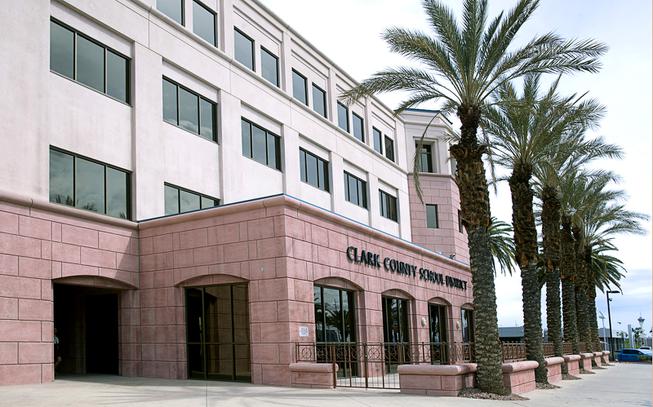
An exterior view of the Clark County School District administrative offices Tuesday, March 29, 2022.
Sunday, Sept. 4, 2022 | 2 a.m.
The Clark County School District will help conceptualize a proposal to be introduced at the next session of the Nevada Legislature to solve the statewide teacher staffing crisis.
The School Board voted unanimously last late month to seek a broad-based bill to improve teacher wages and working conditions, make it easier for the Nevada Department of Education to validate teaching licenses from other states, cover potential new teachers’ application fees, and beef up the state’s education colleges.
The Board won’t actually write the proposed legislation, but its decision gives CCSD — Nevada’s largest school district by far and the fifth-largest school district in the country — sway with lawmakers who can create statewide policy.
“If the largest school district in the state gets behind this, this is something that they will actually address,” Board Member Lisa Guzman said before the Board’s vote Aug. 25.
District government relations staff crafted a resolution last week that introduces the concept to state legislative staff, who may then draft a bill that members of the Nevada Assembly or Senate can introduce once the Legislature reconvenes in February.
Each legislative session, each of Nevada’s 17 school districts gets one bill draft request except for CCSD, which gets two because of its size. CCSD’s second request is a proposal to establish standards and qualifications for all education-related oversight boards, such as K-12 school boards, and the Board of Regents, which governs the state’s public colleges and universities.
But finding and keeping teachers is top of mind in all corners of the state.
CCSD started the school year Aug. 8 down about 1,400 teachers, or about twice the size of its gap to start the pandemic-socked 2020-21 year. Continual teacher separations last year — retirements and other resignations — have added up to roughly 2,300, according to a Sun analysis of personnel reports.
CCSD has taken local steps to recruit, retain and plug holes, including upping the minimum pay for teachers by $7,000 to about $50,000 a year and increasing day rates for substitutes working in high-poverty schools, where vacancies are also typically more severe.
And while the problem is more profound in the Las Vegas area, it’s also being felt across the state. In Washoe County, which includes Reno, there were 147 teacher openings to start the school year last month — an increase from 62 on the first day in 2021-22.
At a Washoe County School District board meeting last month, district human resources director Emily Ellison described stopgap strategies that CCSD also leans on: long-term substitutes, bringing retirees back into the classroom, reassigning central administrators and putting teachers who coach fellow educators back into the classroom.
Washoe Superintendent Susan Enfield said about 60 teacher coaches — who would be called instructional strategists in CCSD — got their new assignments on only a week’s notice, but she had to prioritize student learning over staff learning.
“I am deeply sorry for that,” Enfield said. “One week’s notice before going back into the classroom is not easy and I wish it were otherwise, but we are where we are.”
Lawmaker priorities
State Sen. Scott Hammond, R-Las Vegas, a former educator, said that when he left CCSD in 2015 after 16 years of teaching social studies and Spanish, the district didn’t ask him why.
He said the broad, CCSD-backed bill has major components— namely the retention and pipeline pieces — that “absolutely need to be addressed”.
Assemblywoman Shannon Bilbray-Axelrod, D-Las Vegas, said CCSD’s bill pitches aligned with the findings and priorities of the Legislature’s Joint Interim Standing Committee On Education, and she looked forward to working with the district.
The committee, on which Bilbray-Axelrod serves as vice chair, whittled down its own potential bills and other actions that it would support last week. Among the potential bills: the “Respect Educators Act,” which would create a statewide committee to review the safety and well-being of teachers, and a study of teacher licensure requirements to determine if the exam used nationwide is too much of a barrier.
The committee also said it would send letters to each district superintendent “encouraging” them to increase teacher pay by 20% and bring support staff wages up to at least $20 per hour. CCSD’s pay increase this year, which did not apply to every teacher, was no more than about 16%; if CCSD added 20% across the board, every teacher would make at least $60,000.
The money for more raises, especially for veteran teachers, would come from the Legislature when it sets the state’s budget.
Gov. Steve Sisolak told the Sun last month that he was committed to “making sure that teachers are compensated fairly” and he thought lawmakers were committed, too.
“It’s something that’s obviously got our attention,” he said of the teacher shortage. “Anything that affects our kids is concerning to me.”

